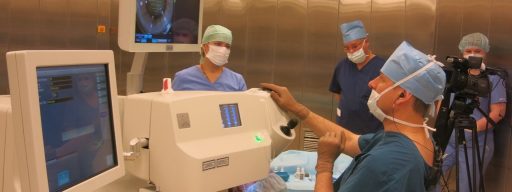A variety of eye pathologies can lead to the development of cataract, a condition in which the lens of the eye becomes cloudy, making it difficult for light rays to be clearly projected onto the retina. As a result, the patient sees a blurry, foggy image with muffled colours, causing difficulties with moving, reading, and driving, especially at dusk and at night.
The weakening of the lens’s zonular apparatus is associated mostly with pseudoexfoliation syndrome, glaucoma, myopia, some forms of retinal dystrophy, traumatic eye injury, or intraocular surgery. When the cataract is hypermature, the lens becomes completely cloudy (white or milky cataract). In all these cases, the lens zonules which support the lens and keep it in the correct position undergo degradation. Subsequently, “wobbling” or subluxation of the lens may develop. In these patients, during cataract procedures, capsular tension rings made of polymer, usually PMMA (polymethylmethacrylate), are used.
- Partially replace the lost lens ligaments (zonular fibres).
- Stretch the lens capsular bag.
- Create the necessary tension on the capsule.
- Restore the circular contour of the capsular bag equator.
Redistribute the forces of the residual zonular ligaments. In patients with traumatic eye injuries or congenital lens subluxation, CTRs are used for anchoring the capsular bag to the sclera. Implanting a capsular tension ring and suturing it to the scleral wall can provide stable fixation of the capsular bag in cases of severe lens subluxation for the years to come.

You can make an appointment by phone from 8:30 to 19:30 (daily).
The Malyugin-modified capsular tension ring is designed specifically for these purposes. It helps the surgeon deal with subluxated lenses in children with Marfan and Weill-Marchezani syndrome, homocystinuria, and other genetic diseases. In adults, this type of capsular ring is useful in cases of blunt and penetrating eye injuries leading to lens ligament damage.
In Russia, this type of surgical intervention has been carried out for more than 20 years, demonstrating very good and stable long-term results.
The risk of adverse effects in the treatment of complicated cataract can be significantly reduced. Risks include significant inflammation, bleeding, and some others. In reducing these risks, the following factors are key:
- The surgeon’s experience and ability to work in nonstandard and less comfortable conditions and overcome emergency situations.
- The quality of preoperative diagnostics.
- The availability of the necessary equipment and surgical devices in the operating theatre.



